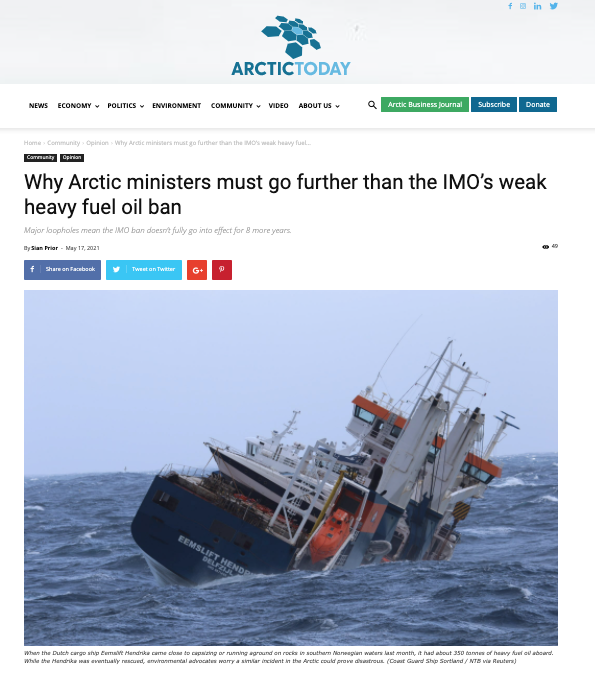Why Arctic ministers must go further than the IMO’s weak heavy fuel oil ban
Major loopholes mean the IMO ban doesn’t fully go into effect for 8 more years.
This op-ed was first published by Arctic Today on 18 May 2021
In November 2020, a decade after the Arctic Council first concluded that oil spills are the greatest risk posed by shipping, the International Maritime Organization finally agreed to ban the use and carriage of heavy fuel oil in the Arctic. A strong, timely ban would protect the Arctic marine environment, as well as the communities who depend on it, from the risk of a disastrous heavy fuel oil spill, while using fuels cleaner than HFO will help to reduce black carbon emissions in the region.
However, the IMO’s Arctic HFO ban is not robust, and fails to protect the Arctic: It allows ships in the Arctic to carry and burn significant quantities of HFO in the coming years, resulting in emissions of black carbon and ongoing spill risk. As a result, the ban fails to achieve protection of a region that is rapidly changing due to climate warming. When the foreign ministers of Arctic Council countries meet in Reykjavík on May 20, they must show commitment to truly ridding the Arctic of heavy fuel oil, ahead of next month’s meeting of the IMO’s Marine Environment Protection Committee, where the final decision on the ban will be taken.
The IMO’s HFO ban will come into force in mid 2024, but only gradually, and will initially only address a small proportion of heavy fuel oil currently being used in the Arctic. It allows for exemptions for ships with protected fuel tanks, and a controversial clause allowing countries which have a coastline bordering Arctic waters to issue waivers for ships flying their flag to keep using HFO. Arctic shipping continues to grow; recent Arctic Council studies of ship activity in the Arctic have shown an increase of 25 percent between 2013 and 2019 and a 75 percent increase in total distance travelled over the same time period. These vessels will be able to make use of these exemptions and waivers, resulting in growth of the amount of HFO being used and carried. This means that the ban will only take truly full effect from July 1, 2029 — which is still more than eight years away.
Unfortunately, we don’t have eight years: Shipping, and the climate crisis is having an impact on the Arctic now. When ships burn HFO, they produce black carbon particles, which are emitted into the environment via their exhaust fumes. These short-lived climate forcers contribute to the warming of the Earth’s atmosphere and when they fall on snow, or on glacier ice and sea ice, they reduce the reflectivity, or albedo, of that surface — and consequently increase how much heat it absorbs. Black carbon emissions from shipping have already increased by 85 percent between 2015 and 2019, and more Arctic shipping using HFO will lead to increased black carbon emissions, further fuelling an already accelerating feedback loop. The IMO’s HFO ban will only reduce the volume of black carbon emissions by a mere 5 percent.
By switching vessels operating in the Arctic to readily available cleaner fuels, or to alternative forms of propulsion, black carbon emissions can be quickly reduced. Use of diesel fuel along with the installation of particulate filters or precipitators, as prescribed for other forms of transport, can reduce emissions of black carbon by more than 90 percent.
The Arctic Council Ministerial provides a unique opportunity for foreign ministers to demonstrate global leadership by committing to rapid, Arctic-wide elimination of heavy fuel oil, and to immediate reduction in black carbon emissions from shipping. These commitments can be enshrined in the 2021 Reykjavik Declaration, to be issued at the conclusion of the meeting.
Specifically, the Clean Arctic Alliance is calling on Ministers to:
- require ships in the Arctic to reduce black carbon emissions by switching to distillate or other cleaner fuels or forms of propulsion when operating in or near the Arctic, and
- strengthen and speed up the implementation of an international ban on the use and carriage of heavy fuel oil as fuel in the Arctic.
Arctic foreign ministers can also show leadership at home, by banning HFO use and carriage in their own Arctic waters and requiring the use of cleaner fuels by nationally-flagged vessels. Norway is already leading the way, by extending an existing ban on HFO in the waters surrounding Svalbard, which will stop all HFO use and carriage in the area. If progress is to be made in dealing with the impact of shipping in the Arctic and protecting the remaining Arctic summer sea ice, ministers from Iceland, the U.S., Canada, Russia, Sweden, Finland, and the Kingdom of Denmark, must follow Norway’s example, and move faster and much more effectively than the IMO, by getting heavy fuel oil out of the Arctic now, rather than waiting another decade.
Sian Prior is the lead advisor to the Clean Arctic Alliance, a group of 22 non-for-profit organizations working to get heavy fuel oil out of Arctic shipping.

